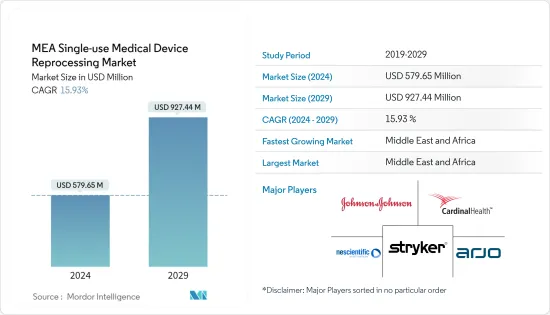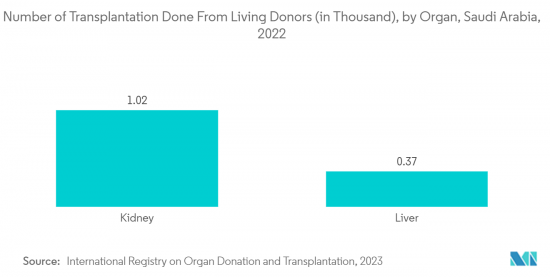PUBLISHER: Mordor Intelligence | PRODUCT CODE: 1403119

PUBLISHER: Mordor Intelligence | PRODUCT CODE: 1403119
MEA Single-use Medical Device Reprocessing - Market Share Analysis, Industry Trends & Statistics, Growth Forecasts 2024 - 2029

The MEA Single-use Medical Device Reprocessing Market size is estimated at USD 579.65 million in 2024, and is expected to reach USD 927.44 million by 2029, growing at a CAGR of 15.93% during the forecast period (2024-2029).
The COVID-19 pandemic significantly impacted the MEA single-use medical device reprocessing market due to the high burden of medical device wastage from various healthcare centers in the Middle East and Africa region. For instance, the Multidisciplinary Digital Publishing Institute article published in November 2022 mentioned that solid waste generation from healthcare facilities, which included personal protective equipment and medical devices, significantly increased from 70 to 300 tons per day during the COVID-19 pandemic. Such a high number of medical devices generated due to the pandemic had a notable impact on the demand for single-use medical device reprocessing, affecting market growth. In addition, the need for single-use medical device reprocessing is expected to remain intact in the Middle East and Africa due to the rising concerns over high medical wastage post-pandemic, thereby contributing to the growth of the market studied over the forecast period.
Factors such as cost savings through reprocessing single-use medical devices, increasing regulatory pressure to reduce the volume of medical waste, the rising burden of chronic diseases, and the growing geriatric population are expected to boost the market studied. According to the report published by BioEnergy Consult in March 2022, between 15-25% of the total amount of medical waste created in the Middle East is considered hazardous or infectious. This remains a serious and pressing health problem for the region. In particular, the use of single-use medical devices like syringes and needles in hospitals and clinics is much more significant when compared to standard devices in Middle Eastern countries. Hence, proper medical waste management is crucial, which can be achieved through medical device reprocessing.
The cost-effectiveness of single-use medical device reprocessing is also expected to contribute to the market's growth. For instance, the South Africa Medical Journal published in April 2022 mentioned that single-use medical device reprocessing would reduce healthcare costs by USD 540 million annually. Such cost-related advantages are expected to boost the demand for single-use medical device reprocessing, fuelling market growth. However, potential material alteration during reprocessing, cross-infection with reprocessed devices, and a general notion regarding the quality of reprocessed single-use medical devices among healthcare providers are expected to impede the growth of the market studied.
Middle East and Africa Single-use Medical Device Reprocessing Market Trends
Catheters and Guidewires in the Class II Devices Segment are Anticipated to Grow Over the Forecast Period
A catheter is a thin tube made from medical-grade materials that serve various functions, including cardiovascular, urological, gastrointestinal, neurovascular, and ophthalmic applications. Catheters can be inserted into the body to treat diseases or perform a surgical procedure. Catheters play a critical role in modern medicine by facilitating minimally invasive procedures, reducing patient discomfort, and improving the diagnostic and treatment capabilities of healthcare professionals.
The demand for catheters and guide wires in the region is expected to increase not only procurement costs of healthcare facilities but also medical waste generated within the region. Hence, there has been driven by an increasing number of cardiovascular and urological diseases, resulting in an increased need for reprocessing equipment. For instance, according to the research study published by the Saudi Medical Journal in January 2023, there was a substantial prevalence of cardiovascular diseases with type-2 diabetes in Saudi Arabia. The reported prevalence of coronary heart disease was 13.4%, 1.7% for cerebrovascular disease, and 0.9% for heart failure. Furthermore, the increasing use of single-use catheters and guidewires, which is expected to drive demand for reprocessing, which is expected to increase the segment's growth over the forecast period. Catheters and guidewires are used during various urological procedures, such as cystoscopy, transurethral resection of the prostate, and other surgeries to provide access, drainage, or irrigation to the urinary tract. Hence, their demand and use are projected to increase over the forecast period. For instance, an article published in Wiley Journal in October 2022 mentioned that the overall prevalence of kidney stones was 17.6% among the Iranian population in 2021, among which 21.53% were men and 14.36% were women. Similarly, according to an article published in December 2021 in the Research Square journal, kidney stones' prevalence in Nigeria was 72.2% among males and 27.8% among female patients in 2021. Such statistics indicates Catheters and guidewires are used during various urological procedures, such as cystoscopy, transurethral resection of the prostate, and other surgeries to provide access, drainage, or irrigation to the urinary tract. Hence, their demand and use are projected to increase over the forecast period.
Thus, reprocessing guidewires and catheters is essential to prevent infections, reduce medical waste, and manage the cost of the procedure. Also, adequately reprocessed devices contribute to improved patient safety and care while reducing the financial burden on healthcare facilities, which is expected to boost the segment's growth over the forecast period.

The GCC is Expected to Witness Significant Growth Over the Forecast Period
The Gulf Cooperation Council (GCC) region comprises the United Arab Emirates, Saudi Arabia, Qatar, Oman, Kuwait, and Bahrain. The Kingdom of Saudi Arabia and the United Arab Emirates are two of the most developed markets in the Middle East and Africa, with a robust healthcare infrastructure. This provides a massive opportunity for the growth of the single-use medical device reprocessing market as there is a rapid adoption of single-use medical device reprocessing tools across the countries.
The demand for reprocessing single-use medical devices is anticipated to rise in conjunction with the growth of the medical waste industry. For instance, according to a W&R report from April 2021, the Emirate of Abu Dhabi produces 6,000 tons of medical waste annually. Similarly, according to an article in Sage Journal, Africa's healthcare facilities have 0.2 million tons of medical waste annually. There is a reasonable growth in the Class I devices segment of this market. The main reasons for reprocessing single-use devices are limited financial resources, waste minimization, and economic feasibility. For instance, the Medgadget Journal in March 2023 indicated that GCC nations generate more than 150 tons of medical waste daily. With a daily production of more than 80 tons of medical waste, Saudi Arabia is the top GCC nation. The rising waste in the countries is augmenting the demand for single-use medical device reprocessing across the region.
Furthermore, the increase in infectious diseases and surgical procedures across the GCC region will likely create a demand for reprocessing medical devices. For instance, as per the November 2021 report of the Dubai Health Authority, about 159 thousand surgeries were performed in the Emirate in 2021. Also, the report stated that Dubai had 52 hospitals across the private and public health sectors, with a bed capacity of 6,400. As pulse oximeters are one of the essential devices used during surgical procedures, their demand for reprocessing is expected to increase in the region over the forecast period.
Moreover, infection control awareness is another important factor on which local companies are working. For instance, companies such as Qatari German Medical Devices participated in HMC Infection Control to provide insight into the workflow. With the focus on infection control across healthcare facilities, stringent regulations are adopted for the reprocessing of single-use medical devices in the GCC.
Thus, these factors, as mentioned above, such as an increase in medical waste generation and a rise in infectious diseases across GCC countries, are expected to collectively drive the growth of the single-use medical device reprocessing market in the GCC region during the forecast period.
Middle East and Africa Single-use Medical Device Reprocessing Industry Overview
The single-use medical device reprocessing market is fragmented and moderately competitive. The major players control a significant share of the market studied. They are involved in new launches, acquisitions, and collaborations with others to gain an edge in the market studied. Some of the key players in the market are Stryker Corporation, Johnson & Johnson, Arjo, Getinge AB, and others.
Additional Benefits:
- The market estimate (ME) sheet in Excel format
- 3 months of analyst support
TABLE OF CONTENTS
1 INTRODUCTION
- 1.1 Study Assumptions and Market Definition
- 1.2 Scope of the Study
2 RESEARCH METHODOLOGY
3 EXECUTIVE SUMMARY
4 MARKET DYNAMICS
- 4.1 Market Overview
- 4.2 Market Drivers
- 4.2.1 Cost Savings Through Reprocessing Single-use Devices
- 4.2.2 Rising Need to Reduce the Volume of Medical Waste
- 4.3 Market Restraints
- 4.3.1 Potential for Material Alteration and Cross Infection with Reprocessed Devices
- 4.3.2 Preconceived Notions Regarding the Quality of Reprocessed Single-use Medical Devices (SUDs)
- 4.3.3 Lack of Regulations for Reprocessing in the Middle East and Africa
- 4.4 Porter's Five Forces Analysis
- 4.4.1 Threat of New Entrants
- 4.4.2 Bargaining Power of Buyers/Consumers
- 4.4.3 Bargaining Power of Suppliers
- 4.4.4 Threat of Substitute Products
- 4.4.5 Intensity of Competitive Rivalry
5 MARKET SEGMENTATION (Market Size by Value - in USD)
- 5.1 By Device Type
- 5.1.1 Class I Devices
- 5.1.1.1 Laparoscopic Graspers
- 5.1.1.2 Scissors
- 5.1.1.3 Forceps
- 5.1.1.4 Scalpels
- 5.1.1.5 Tourniquet Cuffs
- 5.1.1.6 Other Class I Devices
- 5.1.2 Class II Devices
- 5.1.2.1 Pulse Oximeter Sensors
- 5.1.2.2 Sequential Compression Sleeves
- 5.1.2.3 Catheters and Guidewires
- 5.1.2.4 Other Class II Devices
- 5.1.1 Class I Devices
- 5.2 Geography
- 5.2.1 Middle East and Africa
- 5.2.1.1 GCC
- 5.2.1.2 South Africa
- 5.2.1.3 Rest of Middle East and Africa
- 5.2.1 Middle East and Africa
6 COMPETITIVE LANDSCAPE
- 6.1 Company Profiles
- 6.1.1 Stryker Corporation
- 6.1.2 Johnson & Johnson (Sterilmed Inc.)
- 6.1.3 Cardinal Health
- 6.1.4 Medi-Q (Medicare Health Center)
- 6.1.5 NEScientific Inc.
- 6.1.6 Arjo
- 6.1.7 Medline Industries Inc.
- 6.1.8 Getinge AB
7 MARKET OPPORTUNITIES AND FUTURE TRENDS




